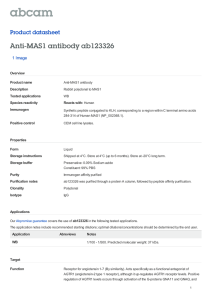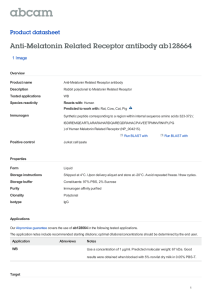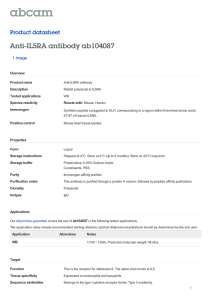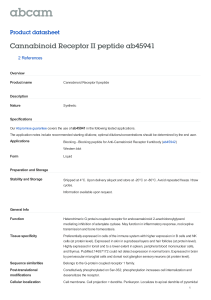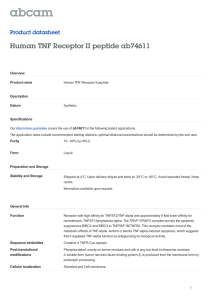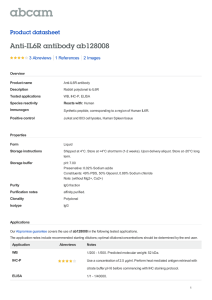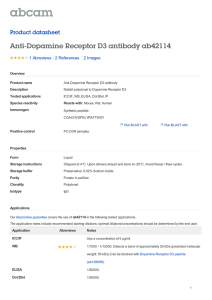Anti-Dopamine Receptor D3 antibody ab115675 Product datasheet 1 Image
advertisement
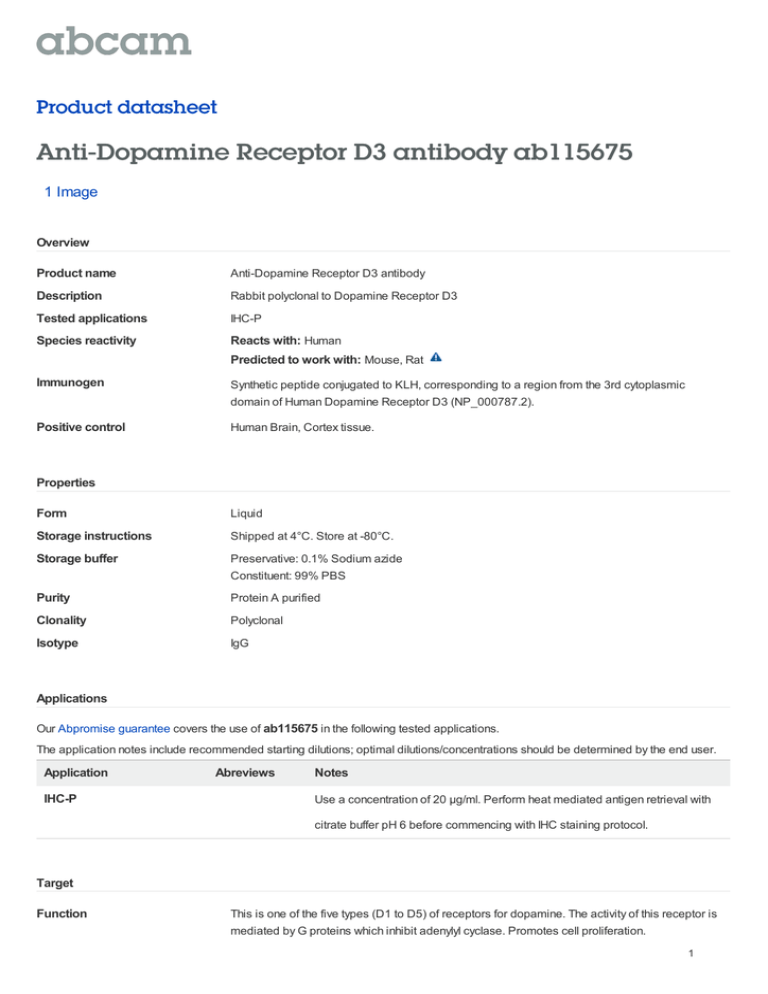
Product datasheet Anti-Dopamine Receptor D3 antibody ab115675 1 Image Overview Product name Anti-Dopamine Receptor D3 antibody Description Rabbit polyclonal to Dopamine Receptor D3 Tested applications IHC-P Species reactivity Reacts with: Human Predicted to work with: Mouse, Rat Immunogen Synthetic peptide conjugated to KLH, corresponding to a region from the 3rd cytoplasmic domain of Human Dopamine Receptor D3 (NP_000787.2). Positive control Human Brain, Cortex tissue. Properties Form Liquid Storage instructions Shipped at 4°C. Store at -80°C. Storage buffer Preservative: 0.1% Sodium azide Constituent: 99% PBS Purity Protein A purified Clonality Polyclonal Isotype IgG Applications Our Abpromise guarantee covers the use of ab115675 in the following tested applications. The application notes include recommended starting dilutions; optimal dilutions/concentrations should be determined by the end user. Application IHC-P Abreviews Notes Use a concentration of 20 µg/ml. Perform heat mediated antigen retrieval with citrate buffer pH 6 before commencing with IHC staining protocol. Target Function This is one of the five types (D1 to D5) of receptors for dopamine. The activity of this receptor is mediated by G proteins which inhibit adenylyl cyclase. Promotes cell proliferation. 1 Tissue specificity Brain. Involvement in disease Genetic variation in DRD3 is associated with essential tremor hereditary type 1 (ETM1) [MIM:190300]. ETM1 is the most common movement disorder. The main feature is postural tremor of the arms. Head, legs, trunk, voice, jaw, and facial muscles also may be involved. The condition can be aggravated by emotions, hunger, fatigue and temperature extremes, and may cause a functional disability or even incapacitation. Inheritance is autosomal dominant. Sequence similarities Belongs to the G-protein coupled receptor 1 family. Post-translational modifications Phosphorylated by GRK4 (GRK4-alpha and GRK4-gamma). Cellular localization Cell membrane. Both membrane-bound and scattered in the cytoplasm during basal conditions. Receptor stimulation results in the rapid internalization and sequestration of the receptors at the perinuclear area (5 and 15 minutes), followed by the dispersal of the receptors to the membrane (30 minutes). DRD3 and GRK4 co-localize in lipid rafts of renal proximal tubule cells. Anti-Dopamine Receptor D3 antibody images ab115675, at 20µg/ml, staining Dopamine Receptor D3 in Formalin-fixed, Paraffinembedded Human Brain cortex tissue by Immunohistochemistry followed by biotinylated secondary antibody, alkaline phosphatase-streptavidin and chromogen. Immunohistochemistry (Formalin/PFA-fixed paraffin-embedded sections) - Anti-Dopamine Receptor D3 antibody (ab115675) Please note: All products are "FOR RESEARCH USE ONLY AND ARE NOT INTENDED FOR DIAGNOSTIC OR THERAPEUTIC USE" Our Abpromise to you: Quality guaranteed and expert technical support Replacement or refund for products not performing as stated on the datasheet Valid for 12 months from date of delivery Response to your inquiry within 24 hours We provide support in Chinese, English, French, German, Japanese and Spanish Extensive multi-media technical resources to help you We investigate all quality concerns to ensure our products perform to the highest standards If the product does not perform as described on this datasheet, we will offer a refund or replacement. For full details of the Abpromise, please visit http://www.abcam.com/abpromise or contact our technical team. Terms and conditions Guarantee only valid for products bought direct from Abcam or one of our authorized distributors 2
